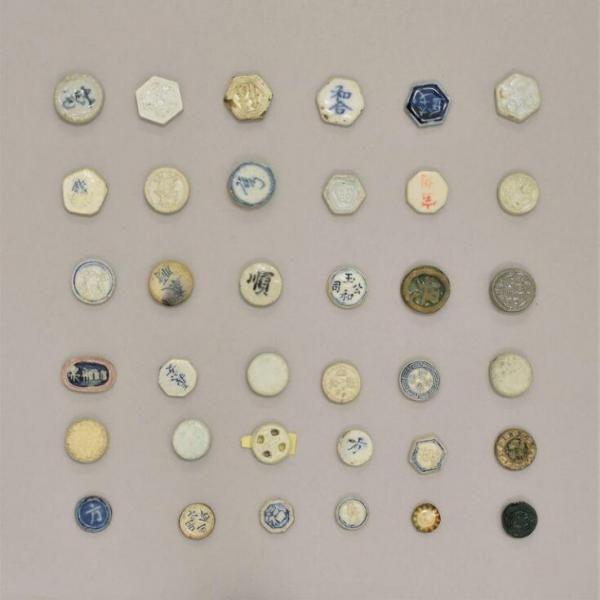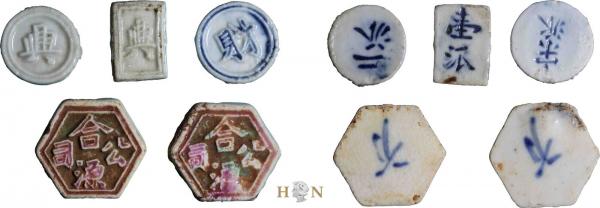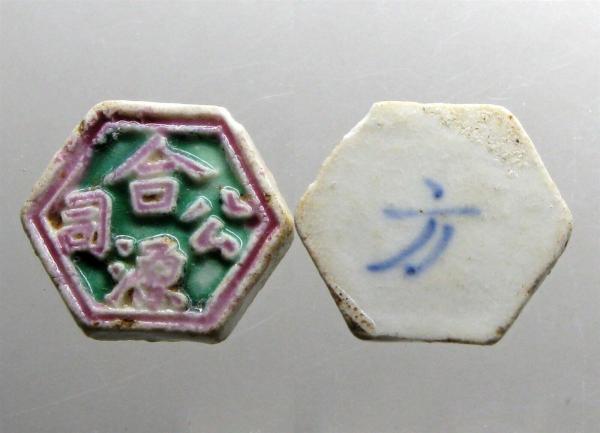2023-5-14
作为大国国粹的赌具,不但源远流长,花样翻新,而且还远播海外,扬我国威,Crazy Rich Asian 中的麻将牌,就是一例。

在大英博物馆的藏品中,就有四百七十多枚泰国华侨组织发行的瓷质的猪仔币,最早于十七十八世纪的时候用于在华人开的赌城里面当赌具,后来就在当地流通,得到过当局承认,用于猪仔贩运和其他货币功能了。据说这类赌具存世量不大,在美国国家历史博物馆里,只藏有叁枚。马来亚华人博物馆中,也只有11枚复制品。

Refers to the small porcelain tokens issued by Chinese organisations in Thailand in the 19th century. These were initially issued as gambling tokens but were also used more generally as a token currency. HARamsden, 'Siamese porcelain and other tokens' (Jun Kobayagawa Co., Numismatic Publishers, Yokohama, Japan, 1911), notes that these porcelain tokens were issued in Chinese-owned gambling houses also known as hong) between the mid-17th and mid-18th centuries, and circulated locally as token currency as far as the issuer's authority was trusted.
无独有偶,维多利亚博物馆中,也藏有叁十六枚猪仔币。可是该博物馆对猪仔币的历史和功用,都所知寥寥,不置可否。

One small box containing 36 tokens made of porcelain, stoneware, or glass, Chinese or Japanese, mainly 19th century. The tokens vary in diameter from ½ inch to 1 inch, and in thickness from 1/8 inch to ¼ inch. The majority are circular; others are hexagonal or octagonal; one is oval. The material is white or yellowish porcelain of varying quality, except for two grey stoneware and one of green glass. Though four are quite plain, the majority have Chinese or Japanese characters on them painted in blue, incised, or stamped in relief. In addition to the inscriptions, a few ornamental motives appear – a crab, a tiger, a fish, and a relief head of the young Queen Victoria, perhaps taken from an English coin or postage stamp.
在广东华侨博物馆、广东省博物馆、中山市博物馆和北京的中国华侨历史博物馆里,也总共藏有四十六枚这种猪仔币。在华侨历史博物馆的专文介绍中说:1860年,清政府被迫与西方列强签订《北京条约》,其中规定清政府准许外国公司在中国招募华工出国。此后,华南沿海地区居民通过契约、赊单、自由华工等途径和身份下南洋、闯美洲讨生活,也有相当多的沿海居民被拐骗、掳掠至海外从事艰苦体力劳动。部分南洋华工终年劳动,所得仅能消费在烟、赌、酒、色上,无法改善自己的处境,更无法赡养国内的亲属,往往最终身无分文,客死他乡。以契约劳工方式前来马来亚谋生的苦力多数被安排到矿场或种植园内工作。部分矿场或种植园头家以特制的代用币来支付工资,俗称猪仔钱。这些代用币由头家自行制造,多数以瓷、陶、金属作原料,并加上各自的特殊印记,仅流通于各自矿场或种植园内,是加强控制和束缚苦力的手段之一。猪仔钱是海外华工辛酸血泪史的重要物证。记得在不久前看过的一个关于下南洋新加坡的电视剧中,有类似的介绍。
猪仔钱在国内甚为罕见,华侨博物院收藏的30枚猪仔钱有圆形、方形、八角形、葫芦形等,一面印有如长发、太兴、美利公司、广顺定记、德盛公司等字样,或者印有动物图桉如龟、蝴蝶、双鱼等;另一面文字如方、五十文、钱、宝、盛等,或者同样印有动物图桉。这些猪仔钱由原新加坡石叻坡文化民俗馆创办人陈来华先生于2004年捐赠。广东华侨博物馆收藏的一枚猪仔钱为圆形,有边廓,正背面分别铭有兴和利字样,应为制作公司的名号。该藏品由已故新加坡华人收藏家杨永曦于2009年10月28日捐赠。中山市博物馆收藏的一组十枚猪仔钱是由陶土烧制而成,也均为瓷质,通体施白釉,底部为素胎,在浅浮凋纹饰之上涂有薄厚不均的彩釉。这批猪仔钱正面标注的农场、庄园或者矿山的名号有茂顺成、万发公司、兴和等,背面有的无字,有的有钱、玉、一百等字样,形状样式不一,有六角形、八角形、蝴蝶形、菱形等,但都是雇佣华工的农场主、庄园主或者矿主为了控制华工的自由、剥削华工血汗的实物证明。这批藏品于2017年12月13日由中山市博物馆征集收藏。广东省博物馆珍藏的五枚猪仔钱,则是华侨后裔杨豪先生从菲律宾带回的,五枚猪仔钱,均为瓷质,通体施白釉,底部为素胎,在浅浮凋纹饰之上涂有薄厚不均的蓝釉。五枚猪仔钱有两种形制:一种是圆形的, 有叁枚,正面中浅浮凋有龟、鹿、鱼叁种纹饰,背面刻八卦纹一周,中央印一钱字。


Porcelain tokens were first used in old Siam as counters for a game called Fantan. The game was one of many played in the Chinese-run gambling houses called hongs. Over time they came to be used as currency within the hong owners' districts and were known as pees. Porcelain gaming tokens, issued by Chinese-owned gambling houses were widely used as money in Siam during the 18th and 19th centuries.
这些陶瓷赌具或钱币,都是在大陆的华侨之乡福建德化和广东潮州窑特别烧制的,而能有这样的经营头脑和想得出这麽损的主意的,归根结蒂也都是一些勤劳勇敢的国人菁英,也就是所谓的侨领和不法商贩。在巨大的利益驱使下,这些国人和华人中的领袖人物不惜欺骗、诱拐、绑架甚至直接掳掠自己的同胞兄弟,把他们当猪仔一样贩运国外。且当时的中外官府也并不严禁此事,睁一只眼闭一只眼,这种无本万利的买卖,才大行其道,对于蛇头人贩子而言,就更是冇走鸡。
In the early 19th century Chinese gambling houses in Bangkok produced porcelain tokens for use as gambling counters. They would exchange them on demand for silver, and changed the designs frequently in order to pre-empt forgeries. At the time there was a shortage of silver for coinage, and the porcelain tokens soon became a popular form of small change in the city. Why porcelain? - Siam had no real porcelain manufacturing industry existing at that time, and therefore gambling houses felt safe that the local people could not produce counterfeits. That is why the porcelain tokens were imported from China. The control of these tokens by the Siamese government became more and more difficult, and at last in 1871, it became necessary to prohibit and stop completely all circulation of these counters. However, the circulation of these tokens continued long after their prohibition. After the turn of the century, gambling was prohibited everywhere except in Bangkok, and after a decade, gambling was prohibited there as well, rendering the tokens useless. The last gambling house in Bangkok shut down its operation with the introduction of the governmental lottery in 1917.
于是国人害国人,内卷窝里斗,就升华成为了大国国粹,是世界历史上的独有特色和亮丽风景。
|
